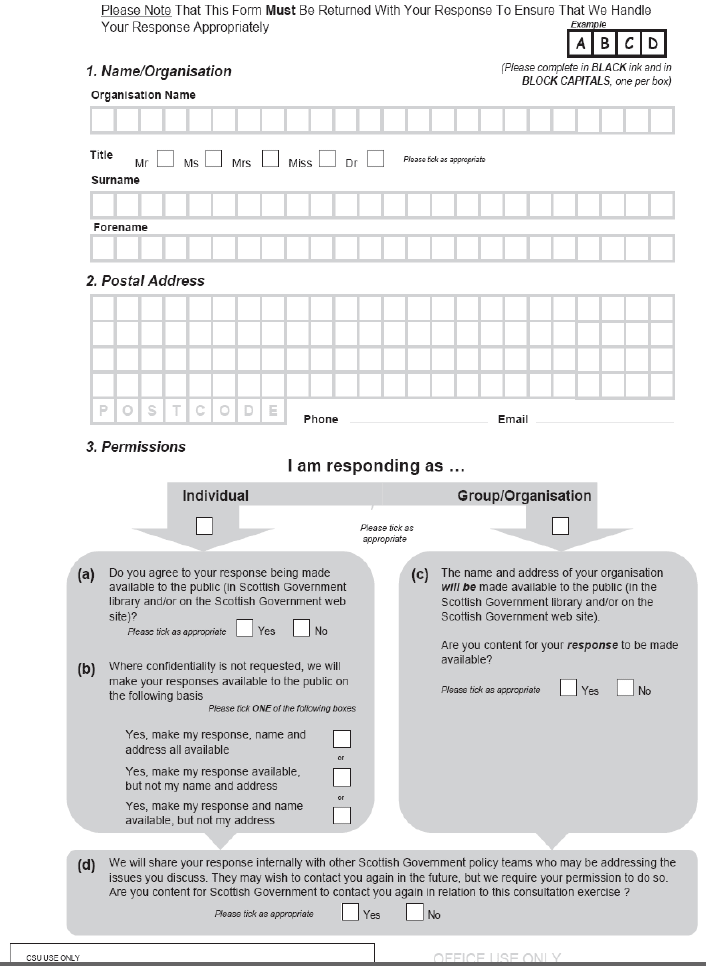Control of Potato Cyst Nematodes: Consultation on the Implementation in Scotland of Directive 2007/33/EC
Consultation on the implementation in Scotland of Directive 2007/33/EC
ANNEX B: THE SCOTTISH GOVERNMENT CONSULTATION PROCESS
Consultation is an essential and important aspect of Scottish Government working methods. Given the wide-ranging areas of work of the Scottish Government, there are many varied types of consultation. However, in general, Scottish Government consultation exercises aim to provide opportunities for all those who wish to express their opinions on a proposed area of work to do so in ways which will inform and enhance that work. The Scottish Government encourages consultation that is thorough, effective and appropriate to the issue under consideration and the nature of the target audience. Consultation exercises take account of a wide range of factors, and no two exercises are likely to be the same.
Typically Scottish Government consultations involve a written paper inviting answers to specific questions or more general views about the material presented. Written papers are distributed to organisations and individuals with an interest in the issue, and they are also placed on the Scottish Government web site enabling a wider audience to access the paper and submit their responses. Consultation exercises may also involve seeking views in a number of different ways, such as through public meetings, focus groups or questionnaire exercises. Copies of all the written responses received to a consultation exercise (except those where the individual or organisation requested confidentiality) are placed in the Scottish Government library at Saughton House, Edinburgh (K Spur, Saughton House, Broomhouse Drive, Edinburgh, EH11 3XD, telephone 0131 244 4565). All Scottish Government consultation papers and related publications (eg, analysis of response reports) can be accessed at: Scottish Government consultations ( http://www.scotland.gov.uk/consultations) You can telephone Freephone 0800 77 1234 to find out where your nearest public internet access point is.
The Scottish Government now has an email alert system for consultations (seconsult: http://www.scotland.gov.uk/consultations/seconsult.aspx). This system allows stakeholder individuals and organisations to register and receive a weekly email containing details of all new consultations (including web links). seconsult complements, but in no way replaces SG distribution lists, and is designed to allow stakeholders to keep up to date with all SG consultation activity, and therefore be alerted at the earliest opportunity to those of most interest. We would encourage you to register.
The views and suggestions detailed in consultation responses are analysed and used as part of the decision making process, along with a range of other available information and evidence. Depending on the nature of the consultation exercise the responses received may:
- indicate the need for policy development or review
- inform the development of a particular policy
- help decisions to be made between alternative policy proposals
- be used to finalise legislation before it is implemented
Final decisions on the issues under consideration will also take account of a range of other factors, including other available information and research evidence.
While details of particular circumstances described in a response to a consultation exercise may usefully inform the policy process, consultation exercises cannot address individual concerns and comments, which should be directed to the relevant public body.
Please send your response by 29 May 2009 to:
Jean.Waddie@scotland.gsi.gov.uk , or
Jean Waddie
Scottish GovernmentPlants, Horticulture and Potatoes,
Room 251
Pentland House
47 Robb's Loan
Edinburgh
EH14 1TY
If you have any queries contact Jean Waddie on 0131 244 4895.
We would be grateful if you could order your response according to the numbered questions in this paper, as this will aid our analysis of the responses received.
Handling your response
We need to know how you wish your response to be handled and, in particular, whether you are happy for your response to be made public. Please complete and return the Respondent Information Form enclosed with this consultation paper as this will ensure that we treat your response appropriately. If you ask for your response not to be published we will regard it as confidential, and we will treat it accordingly. All respondents should be aware that the Scottish Government are subject to the provisions of the Freedom of Information (Scotland) Act 2002 and would therefore have to consider any request made to it under the Act for information relating to responses made to this consultation exercise.
Next steps in the process
Where respondents have given permission for their response to be made public, these will be made available to the public in the Scottish Government Library by 26 June and on the Scottish Government consultation web pages by 30 June. We will check all responses where agreement to publish has been given for any potentially defamatory material before logging them in the library or placing them on the website. You can make arrangements to view responses by contacting the SG Library on 0131 244 4552. Responses can be copied and sent to you, but a charge may be made for this service.
What happens next?
Following the closing date, all responses will be analysed and considered along with any other available evidence to help us decide how to implement the new PCN Directive. We aim to issue a report on this consultation process by the end of the summer and will then prepare the necessary legislation and issue new guidance in time for the implementation date of 1 July 2010.
Comments and complaints
If you have any comments about how this consultation exercise has been conducted, please send them to
John Speirs
Scottish GovernmentPlants, Horticulture and Potatoes
Room 251
Pentland House
47 Robb's Loan
Edinburgh
EH14 1TY
or John.Speirs@scotland.gsi.gov.uk
RESPONDENT INFORMATION FORM

There is a problem
Thanks for your feedback